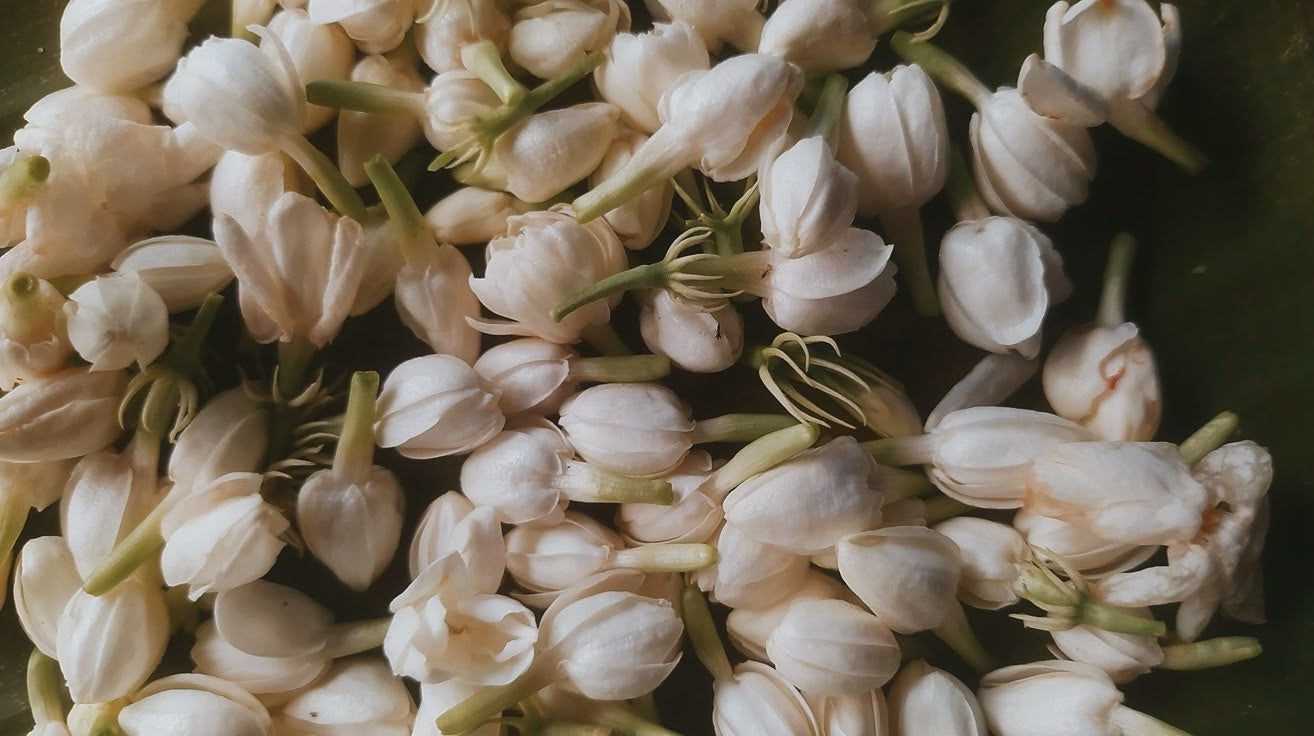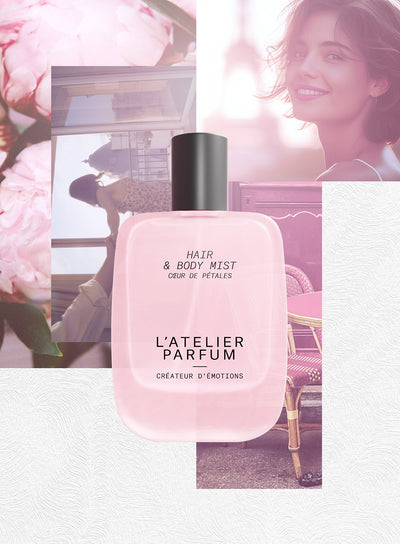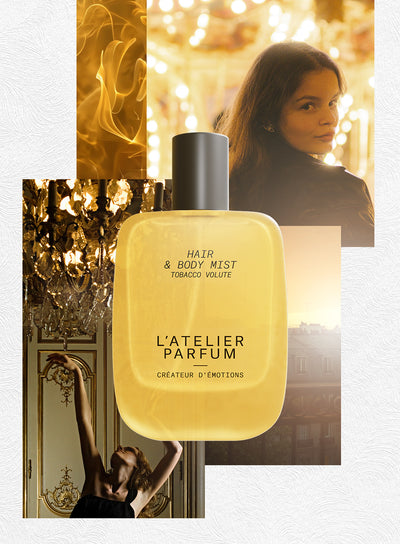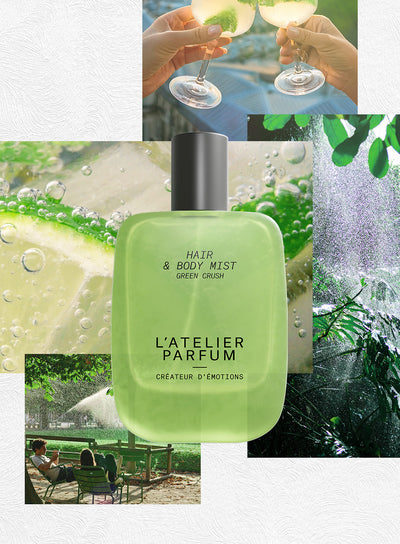Jasmine: The Timeless and Floral Soul of Perfumery

Botanical Origin
Jasmine belongs to the genus Jasminum, which includes more than 200 species of climbing plants and shrubs in the Oleaceae family. The notable species in perfumery are:
- Jasminum grandiflorum (Spanish or royal jasmine)
- Jasminum sambac (Arabian or night-blooming jasmine)
- Jasminum officinale (common jasmine)
- Jasminum auriculatum (Indian jasmine)
- Jasminum fluminense (Brazilian jasmine)
These plants originated in Southeast Asia, India, and Persia, but have acclimated around the Mediterranean region, as well as in Egypt, Morocco, and Grasse. Their signature is star-shaped, white or cream flowers with a sweet, heady, and hypnotic aroma. Jasmine grows as bushes or vines reaching up to 6 meters, clinging to supports and draped in dark green foliage.
History of Jasmine
Jasmine’s story dates back over 2,000 years in Persia, where its flowers were sacred, offered to the gods, or used in royal baths and perfumes. Its name, “yasamin,” means “gift of God” in Persian, symbolizing both purity and passionate love.
In ancient India and China, it graced temples, ceremonies, and bridal finery, evoking innocence and fertility. The Egyptians used it as early as 1,000 BCE in rituals and body care for its powerful fragrance and longevity.
Introduced to Europe in the 16th century, it quickly won over the aristocracy. By the 18th century, Grasse became the world capital of perfumery jasmine — the flower resonated at the heart of the most mythical compositions. Called “the flower of flowers” or “the heart’s flower” by perfumers, it symbolizes sensuality, femininity, and emotional strength.
Cultivation of Jasmine
Jasmine demands talent, patience, and humility to cultivate. It thrives:
- In a warm, humid climate on rich, well-drained soils (France, Egypt, India, Morocco, China…)
- With carefully managed irrigation, not too much (to avoid root disease), not too little (to avoid stunted flowers)
- Through propagation by cuttings (for consistent aromatic character)
Harvesting is both an art and a science: every morning (before sunrise), thousands of flowers must be hand-picked in the cool dawn when their fragrance peaks. It takes over 8,000 flowers just for one kilogram; their fragility means immediate transformation is necessary to preserve their scent. An experienced picker can gather about 2 kg of flowers in a morning, maintaining a ritual atmosphere of dedication and tradition.
In France and Egypt, the main flowering period runs from June through December.
The Process of Transforming Jasmine into Perfume Oil
In the past, jasmine was processed by enfleurage — an ancient manual method in which flowers rested on fat to capture the aroma (now rare, except in top-level artisanal production).
Modern methods include:
- Solvent extraction (primarily hexane or petroleum ether)
- Flowers are macerated, producing a “concrete” (a fragrant, waxy substance).
- Alcohol washing yields the absolute: a concentrated elixir, the vibrant heart of jasmine.
- Supercritical CO₂ extraction (innovative processes, improved yield, finer aromatics)
- Steam distillation (rare, as the flower is very delicate)
The yield is extremely low: about 800 kg of fresh flowers for 1 kg of concrete, yielding roughly 600 g of absolute, making it one of the world’s most precious materials.
Olfactory Profile of Jasmine
Jasmine is an olfactory paradox: pure, indolic, luminous, narcotic, animalic...
- Top notes: Fruity, green, sometimes lemony brightness
- Heart: Opulent, creamy, heady floral bouquet with notes of honey and apricot
- Base: Musky, slightly animalic, sometimes powdery or honeyed
Its olfactory richness comes from molecules such as indole, linalool, and benzyl acetate. Origin impacts nuance: Indian jasmine is greener and more herbaceous; Egyptian jasmine is softer and more honeyed.
The Different Species of Jasmine
Each species has a unique olfactory signature and a particular perfume history:
- Jasminum grandiflorum
Common name: Royal, Spanish jasmine
Origin: India, Egypt, France
Olfactive profile: Floral, sweet, fruity, creamy, powdery - Jasminum sambac
Common name: Arabian, night jasmine
Origin: India, SE Asia
Olfactive profile: Enveloping, exotic, opulent, animalic, with green tea note - Jasminum officinale
Common name: Common jasmine
Origin: Central Asia Floral
Olfactive profile: slightly spicy, classic, sometimes sweet - Jasminum auriculatum
Common name: Indian jasmine
Origin: India
Olfactive profile: Rich, spicy, gourmand, warm, oriental nuances - Jasminum fluminense
Common name: Brazilian jasmine
Origin: Brazil
lfactive profile: Fresh, green, slightly fruity
Each inspires emotions, uses, and distinctive signatures depending on the perfumer’s intent.
Jasmine’s Effects on Mood, Emotion, and Psychology
Beyond its scent, jasmine is a well-being ally:
- Calming, reduces stress and anxiety
- Promotes deep, restorative sleep
- Stimulates joy, optimism; acts as a natural antidepressant via dopamine release
- Aphrodisiac, symbol of passion, sensuality, and self-confidence
- Source of comfort, recenters and opens the heart
Aromatherapy uses it for its comforting effects during periods of stress, instability, or fatigue, weaving an immediate connection between perfume and inner balance.
Robertet’s Actions in Jasmine Cultivation
Robertet stands as a pioneer of a sustainable and fair jasmine supply chain worldwide. Their CSR strategy is based on three pillars:
- Responsible and Traceable Sourcing
.Auditing supply chains and certifying social and environmental practices
. Long-term relationships with growers (India, Egypt, Grasse)
. Considering community needs: fair pay, safety, social development - Respectful Transformation
. Innovations in extraction (supercritical CO₂, green chemistry)
. Optimizing water and energy use
. Reducing carbon footprint and greenhouse emissions (SBTi – Science Based Target Initiative) - Creation and Innovation
. Developing new certified, upcycled, low-impact products
. Raising staff awareness of biodiversity and environmental issues around the world
Robertet provides clients with guarantees of traceability, safety, and authenticity, while valuing biodiversity and people.
Iconic Jasmine-Based Perfumes
Jasmine, a star ingredient, structures many masterpieces:
- J’adore, Dior - 1999: Fruity floral, grandiflorum jasmine, ylang, rose
- N°5, Chanel - 1921: Aldehydic floral, Grasse jasmine at heart
- Joy, Jean Patou - 1930: Intensely jasminic floral, rose
- Fils de Joie, Serge Lutens - 2020: Sambac jasmine, narcissus, musks, sweet spices
- L'Heure Bleue, Guerlain - 1912: Powdery floral, jasmine, iris, violet
- Alien, Mugler - 2005: Sambac jasmine, amber woods, cashmeran
- Songes, Annick Goutal - 2005: Sambac jasmine, tiare, frangipani, vanilla
- Diorissimo, Dior - 1956: Jasmine, lily of the valley, ylang, green
Jasmine illuminates both historic icons and the most modern creations, lending sensuality, brightness, and a backbone to the composition.
L’Atelier Parfum Fragrances Featuring Jasmine
L’Atelier Parfum’s collection explores jasmine’s diverse olfactory spectrum, revealing its softness, brilliance, depth, and emotional power:
- Douce Insomnie: Jasmine, tonka bean, iris – an enveloping powdery floral
- Arme Blanche: Jasmine, white musk, sandalwood – luminous, intense, and reassuring floral
- Dose of Rose: Rose, sambac jasmine, vetiver – a sensual chypre floral
- Leather Black Knight: Leather, jasmine, black spices – a modern, mysterious leather chypre
- White Mirage: Jasmine, orange blossom, musk – solar, radiant floral
- Berry Shiver: Red berries, grandiflorum jasmine, fresh notes – a vibrant fruity floral
Each fragrance is an expression of a creative vision—highlighting nature through emotional, ethical, and utterly contemporary compositions.
Sources:
Fragrantica : Jasmine Note
Perfume Society – Jasmine
Marie Claire : Best Jasmine Perfumes
Glamour : Best Jasmine Perfumes





